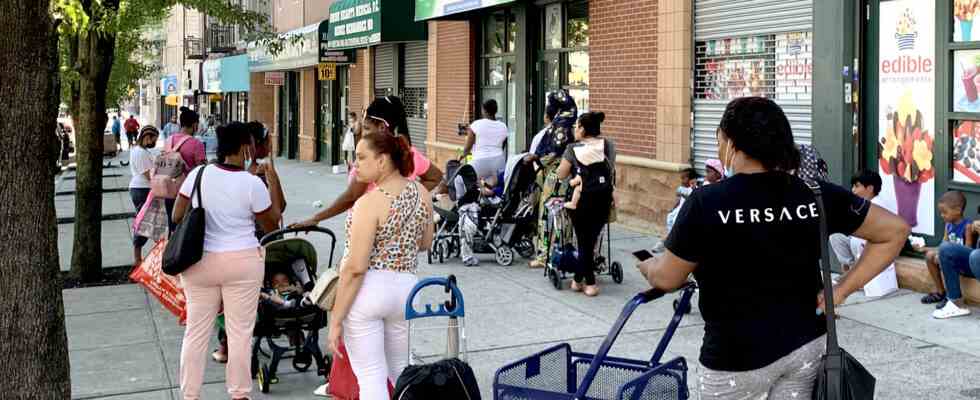background
Status: 08/15/2022 08:24 a.m
In New York, inflation is higher than it has been in decades. One in four people in some parts of the city could soon have trouble getting a meal. Food banks are doubly struggling.
“I wouldn’t normally be able to give an interview in this room,” says Maria Cintron. She is the manager of The HopeLine food bank in New York’s South Bronx. The small chamber at the end of the facility is usually stacked with boxes of rice, pasta, or canned food. At the moment it is difficult to get all these products. “Vegetables and fruit have always been scarce for Tafel, but now non-perishables are also hard to come by,” she says.
At almost nine percent, inflation in New York is the highest it has been in 40 years. The high prices affect food banks and pantries in many ways: The increased prices not only make more people needy because they can no longer afford goods in the supermarket. Food is also becoming less and less affordable for the food banks, because many of the donating organizations are also under pressure. The chambers are clearly feeling the global aftermath of the pandemic, staff shortages, the war in Ukraine and the chaos in the supply chains.
Bronx is a “food desert”
“The HopeLine” has been serving needy New Yorkers in the South Bronx for more than 30 years. Like most poor neighborhoods in major American cities, the district is known as the “food desert”: these are areas where fresh, healthy and nutritious foods such as fruit and vegetables are hard to come by. The density of bodegas, i.e. small kiosks, is often high, but supermarkets with a large selection are rare.
Even before the pandemic, many people here lived in so-called food insecurity. According to a study by the United Hospital Fund and the Boston Consulting Group, one in four people in the Bronx will soon not know where their next meal is coming from.
Pandemic has increased demand
Families in need can pick up a bag of groceries from “The HopeLine” once a month, but only after prior registration. “That’s why we don’t have snakes, but we know exactly how many families need more help.” Since the beginning of the pandemic, around 3,000 additional families have registered, but a maximum of 1,500 can come per month.
In the pandemic, many new food banks and pantries have sprung up in New York City to meet the sudden hardship in neighborhoods. “That’s good,” says Cintron, “but the grants from the city and the major sponsors are now distributed among more institutions. That means we have less of the cake.” And when the grants come, the high prices make it difficult to buy enough food.
Prices are rising everywhere
Maria Ferrera stops by regularly to pick up a bag. She lost her job during the pandemic and hasn’t worked since. The high prices she sees in the supermarkets worry her. “Meat and cooking oil have become particularly expensive. I’m struggling to get enough food for myself and my family. I very much hope that the prices will go down again.”
Little Kayla took a stuffed animal off the shelf. Her mother Dayenne smiles broadly with her daughter, she is happy to be able to make the four-year-old happy. “The people here are real lifesavers,” she says. Her other two children are two and seven years old, she works as an assistant teacher in a school, and her husband also has a job. Even so, they’re short on money. “We come here once a month, which really helps us a lot. The prices in the supermarket have gone through the roof.”
Gasoline and rent have also become expensive, explains Cintron, as have diapers and baby food. Of course, if these things cost more, that reduces the family budget for groceries.
Supply bottlenecks exacerbate the problem
Mark Cohen is a professor of retail at Columbia University Business School. The government “is already reacting as aggressively as it can by raising Federal Reserve rates,” he told The Gothamist news site. President Joe Biden has also urged oil and gas companies to increase production to lower gasoline prices. Nevertheless, he expects food prices to remain high for at least a year before the effects become noticeable.
“Just yesterday one of our shipments finally got here late,” explains Maria Cintron of the South Bronx Food Bank. “Right now we have some food to hand out at the front of the store – but you just can’t count on it.” A supplier recently brought drugstore items and medicines, although the Tafel employees had actually expected vegetables. It has also happened that products arrived late and spoiled at the Tafel due to the delivery bottlenecks and had to be thrown away.
The “HopeLine” is even better organized than others: there are soup kitchens and food banks that only work with volunteers and without a computer system. “Imagine people queuing around the block and then instead of three pallets of groceries, only two arrive. It’s just hard,” says Cintron. “We catch a lot of what the city and government should actually solve,” she says. “It’s important to us that this is noticed.”

